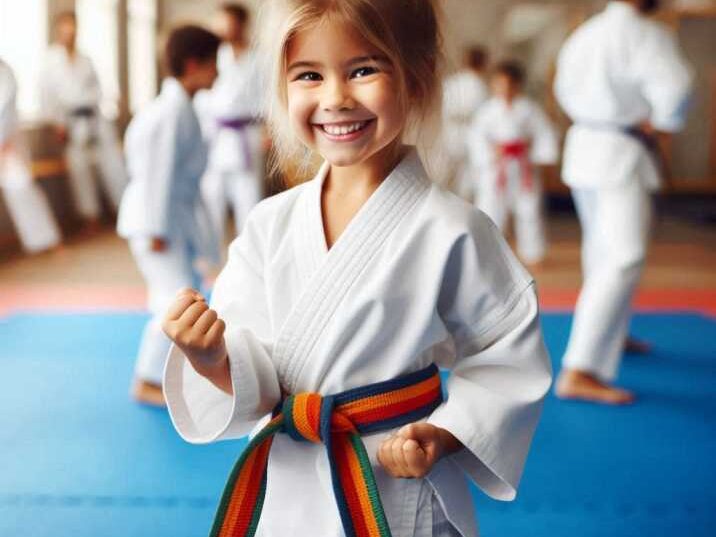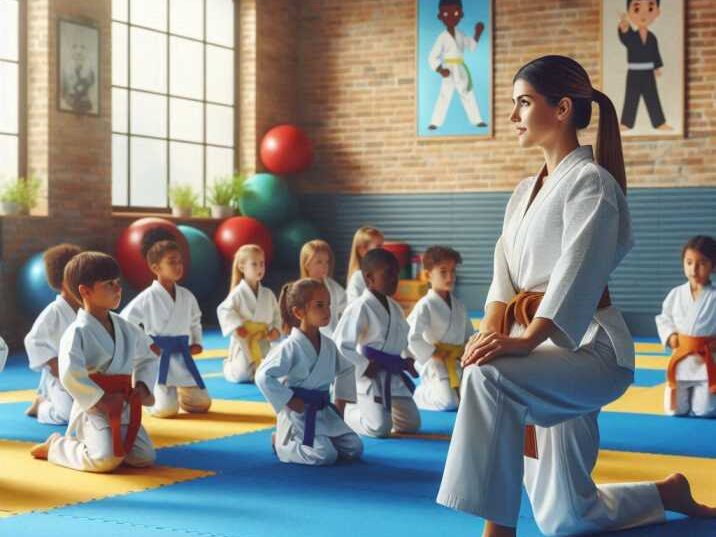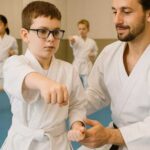Introduction
Table of Contents
Every parent wants their child to feel confident, strong, and ready to take on challenges. But for many kids, especially those who are shy or quiet, building confidence can be tough.
One powerful way to support your child’s growth is through martial arts for kids confidence. While most people think of martial arts as a way to stay active and learn self-defense, the truth is that it goes much further. Martial arts help children improve their mental strength, social skills, and self-belief.
In martial arts classes, kids learn discipline, respect, and focus. They achieve goals step by step, earn belts, and see their hard work pay off. This structured progress is what makes martial arts such a strong tool for boosting confidence, both inside and outside the dojo.
If you’re wondering how martial arts can help your child feel more self-assured, this guide will break down the benefits, address common concerns, and show you why so many parents see martial arts as a confidence-building path for kids.

What Martial Arts Means for Kids
Martial arts are structured systems of training that include self-defense, discipline, and physical activity. Kids often start with styles like karate, taekwondo, judo, or Brazilian jiu-jitsu. Some schools also offer kung fu, aikido, or mixed martial arts designed for children.
For children, martial arts are more than just combat sports. They are a safe and guided environment where they learn:
- How to respect instructors and peers
- The importance of practice and patience
- Ways to control their body and emotions
- Healthy competition and teamwork
- Goal-setting and persistence
This balance of physical and mental training makes martial arts unique compared to other activities. Unlike casual sports, martial arts also emphasize personal growth and discipline, which directly helps children gain confidence.
The Benefits of Martial Arts for Kids Confidence
1. Building Self-Esteem Through Achievements
Kids earn belts or stripes after consistent effort. Each new level is proof of progress. These milestones show children that hard work pays off, which increases self-confidence. They learn that success is a result of practice and persistence, not luck.
For example, when a child practices a kick for weeks and finally performs it correctly, they feel proud of themselves. That small success adds up over time, creating a confident attitude.
2. Learning Discipline and Focus
Martial arts demand attention to detail. Children must listen, follow directions, and practice routines. These habits help them stay focused in school and at home, boosting self-belief in their abilities.
Instructors often teach kids to bow before class, stay quiet when others are speaking, and repeat moves carefully. These small acts of discipline build habits that give children a sense of responsibility and confidence in handling tasks.
3. Developing Social Skills
Classes include group training, sparring, and teamwork exercises. Shy children make friends in a supportive setting. Positive social interaction builds confidence in speaking, sharing, and leading.
For kids who struggle with social anxiety, martial arts provide a structured way to interact with others. They learn to encourage teammates, cheer for each other, and respect boundaries. These social skills carry over into school and daily life.
4. Handling Fear and Pressure
Martial arts introduce controlled challenges, such as sparring matches or demonstrations. Facing these situations teaches kids to stay calm under pressure. Each small victory builds resilience and courage.
For example, a child may feel nervous before their first sparring match. With encouragement and training, they face the situation and realize they can handle it. That moment of overcoming fear directly boosts their confidence.
5. Encouraging a Growth Mindset
Mistakes are part of training. Kids learn that failure is not the end, but a chance to improve. This mindset strengthens their confidence not only in martial arts but also in academics and life.
When kids fall while practicing judo or struggle with a taekwondo form, instructors teach them to try again. Over time, they learn that progress is built through effort, not perfection. This lesson stays with them for life.
6. Improving Physical Fitness and Body Confidence
Physical strength and health also contribute to confidence. Martial arts help kids build coordination, balance, flexibility, and stamina. As they get stronger, they feel more capable.
Children who once felt clumsy start moving with control. When they realize their bodies can do more than they thought, their self-image improves. This body confidence often leads to higher self-esteem.
7. Respect and Responsibility
Respect is a core value in martial arts. Kids learn to bow, say thank you, and treat instructors with honor. These lessons teach them to value others, which in turn makes them more confident in their interactions.
By following routines, keeping uniforms clean, and attending class regularly, children also learn responsibility. Taking charge of their own progress makes them feel capable and confident.
8. Leadership Development
As children grow in martial arts, many schools allow them to assist instructors in teaching younger students. This role builds leadership and responsibility. Teaching or helping others is one of the strongest ways to develop confidence.
When a child explains a move to a classmate or leads a warm-up exercise, they feel proud and trusted. That leadership experience shapes their personality in school and later in life.
9. Supportive Group Environment
Martial arts classes give children a chance to connect with peers in a structured but supportive way. They train together, spar respectfully, and encourage one another. This group setting helps shy children break out of their shell, build friendships, and feel part of a community. A child who once felt alone now has teammates cheering for them, which directly boosts confidence.
10. Size Doesn’t Matter
Unlike sports that favor height or speed, martial arts welcome children of all body types. Success depends on determination and practice, not size. Smaller kids learn that they can still be strong and skilled, while bigger kids realize that technique matters more than power. This helps children stop worrying about body image and focus on their abilities, building healthy confidence.
11. Positive Coping Skills
Martial arts training shows children how to handle stress calmly. When challenges come up, kids learn to focus, breathe, and turn nervous energy into progress. These coping skills are valuable not just in class but also in daily life. A child who learns to stay calm during sparring can also stay calm during exams or social situations, protecting their confidence from setbacks.
12. Progress Over Perfection
Many kids today feel pressured to be perfect, which can hurt their confidence. Martial arts teach them that progress matters more than perfection. Every belt earned and every new move mastered shows that improvement is the goal. This lesson helps kids accept themselves and feel proud of steady growth, rather than being discouraged by unrealistic standards.
13. Exercise Improves Mood and Confidence
Exercise is proven to release endorphins and boost mood. Martial arts combine physical activity with mental focus, giving kids a natural confidence boost. Research shows exercise improves children’s behavior and focus by redirecting brain resources away from anxiety. Martial arts classes let kids release stress, replace negative energy with positive effort, and feel stronger inside and out.
Possible Risks or Concerns for Parents
Parents often wonder if martial arts are safe. While injuries can happen in any sport, martial arts programs for children are usually designed with safety in mind. Common concerns include:
- Minor bruises or bumps during sparring
- Overtraining if too many classes are taken
- Fear of aggressive behavior
- Nervousness in shy kids at the start
In reality, martial arts teach kids to avoid fights and use skills only for defense. With the right school and instructors, risks stay low. Parents can ease concerns by choosing certified instructors, monitoring progress, and communicating with their child about how they feel.
Safety Tips and Best Practices
To make martial arts safe and confidence-building, follow these steps:
Choose certified instructors with experience teaching children
A trained instructor understands both martial arts techniques and child psychology. They know how to keep kids safe while teaching them discipline and confidence. Certification also ensures they follow safety guidelines and age-appropriate methods. Always check credentials before enrolling your child.
Start with beginner classes before advancing to sparring
Beginner classes focus on basics like stance, balance, and simple moves. This foundation lowers the risk of injury later. Sparring should come only after your child builds skills and confidence. Gradual progress makes training safer and more enjoyable.
Use protective gear like gloves, mouthguards, or helmets
Proper gear prevents common injuries such as bruises, cuts, or dental damage. Gloves cushion the hands, mouthguards protect the teeth, and helmets reduce the chance of head injuries. Teaching kids to value protective equipment also builds lifelong safety habits.
Ask about class sizes; smaller groups mean more attention
In small groups, instructors can correct mistakes quickly and give each child personal attention. Large classes often make it easy for shy or struggling kids to get overlooked. Smaller settings help children learn better and stay safer during training.
Encourage regular rest days to avoid burnout
Too much training can cause fatigue, stress, or even injuries. Rest days give muscles time to recover and keep kids motivated. A balanced schedule ensures martial arts remain fun while supporting steady growth in skill and confidence.
Talk to your child after class to check how they feel
Regular conversations help you understand your child’s experience. If they feel uncomfortable, you can address issues early with the instructor. Asking how they feel also shows support, boosting their confidence and willingness to continue.
Make sure the school promotes respect and non-violence
Martial arts should teach kids discipline, self-control, and respect for others. Schools that stress non-violence create a safe learning environment. This approach ensures your child learns martial arts as a tool for confidence, not aggression.
Watch a class before enrolling your child
Observing a session helps you see how instructors interact with kids. You’ll notice whether the environment is safe, structured, and supportive. Watching also gives you confidence that the teaching style fits your child’s needs. It’s a simple but powerful step.

Comparison with Other Activities
Some parents compare martial arts with sports like soccer, basketball, or swimming. While these activities also build confidence, martial arts focus more directly on discipline, respect, and personal growth.
Soccer builds teamwork but not always individual confidence
Soccer teaches kids how to work together and trust their teammates. However, children who are shy or less skilled may feel left out if they don’t get the ball often. Their confidence may depend on team performance rather than personal progress. This can limit how much soccer helps build self-esteem on its own.
Basketball boosts coordination and communication, but the focus is often on winning
Basketball requires quick movements, strong coordination, and constant communication. These skills are valuable, but games often center on scores and victories. Kids who struggle to keep up may feel pressure or discouragement. The competitive focus can sometimes overshadow confidence-building.
Swimming improves fitness but may not address social skills
Swimming is excellent for stamina, strength, and overall health. Yet, it is often practiced individually with little interaction between kids. While it benefits physical confidence, it doesn’t always help children build friendships or social confidence. For shy kids, this can leave an important gap.
Martial arts balance physical fitness, mental strength, respect, and personal growth
Martial arts combine exercise with lessons in discipline, self-control, and respect. Each child progresses at their own pace, focusing on personal growth instead of competition. This balance helps kids gain both physical and mental confidence. It supports long-term character development alongside fitness.
This does not mean martial arts are better than all other activities, but they provide a unique combination of benefits that target both mind and body. Many parents also combine martial arts with other activities to give their children a balanced experience.
Real-Life Examples
- A shy 7-year-old who avoided speaking in class gained the courage to perform in front of parents during a martial arts demonstration.
- A child struggling with bullying used martial arts confidence to stand tall, avoid conflict, and speak up to teachers without fear.
- Parents often report that their children’s grades improve after joining martial arts because focus and discipline transfer to academics.
Table: Benefits vs. Concerns
| Benefits for Confidence | Possible Concerns |
|---|---|
| Improved self-esteem | Minor bruises |
| Better focus and discipline | Risk of overtraining |
| Stronger social skills | Shyness at first |
| Resilience under pressure | Parental worry about safety |
| Growth mindset | Misconception of aggression |
| Physical fitness and body image | Nervousness in first classes |
Conclusion
Martial arts offer more than kicks and punches. They build confidence, focus, discipline, and resilience. For parents searching for a structured, safe, and rewarding activity, martial arts give children the tools to believe in themselves.
Confidence is a skill, not a gift. Through martial arts, kids practice this skill every day. And as their confidence grows, so does their ability to face challenges in school and life.
FAQs
1. At what age can kids start martial arts?
Most schools accept children as young as 4 or 5 years old. Programs are adjusted for age and maturity.
2. Will martial arts make my child aggressive?
No. Martial arts teach respect, self-control, and peaceful conflict resolution.
3. How often should kids train?
Two to three times a week is ideal for progress without overtraining.
4. Can shy children benefit from martial arts?
Yes. Martial arts help shy kids open up, build friendships, and gain confidence step by step.
5. What type of martial art is best for confidence?
Karate and taekwondo are popular for beginners, while jiu-jitsu builds problem-solving skills. The best choice depends on your child’s interests.


